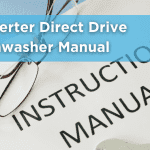Table of Contents
Leftover food particles and moisture cause mold in dishwashers. When the dishwasher stays damp and has bits of food, mold finds it a perfect place to grow. Regular cleaning can help prevent it. If you’ve noticed an unpleasant odor or visible mold, it’s essential to address it as soon as possible. This guide will walk you through the steps to identify, remove, and prevent mold in your dishwasher.
Identifying Mold in Your Dishwasher
- Discoloration & Residue: Mold often appears as discoloration or a slimy residue.
- Musty Odor: A strong, musty smell clearly indicates mold.
- Check Removable Parts: Remove any baskets, trays, and filters. Inspect them closely for mold signs.
- Inspect the Filter: While a dirty filter doesn’t necessarily mean mold, a blackened or musty-smelling housing indicates mold presence.
Tip: If unsure, always consult with a professional. Early identification can prevent health issues.
How to clean mold in a dishwasher?
Mold in your dishwasher is more than unsightly; it can also be a health hazard. The warm and moist environment makes dishwashers prime real estate for mold growth. Here’s a comprehensive guide to help you tackle this issue effectively.
1. Safety First
Before you begin, it’s crucial to prioritize your safety:
- Gloves: Wear thick rubber gloves to protect your hands from direct contact with mold and cleaning agents.
- Goggles will shield your eyes from mold spores, preventing irritation and potential infections.
- N-95 Respirators: Mold spores can be harmful when inhaled. An N-95 respirator ensures you don’t breathe in these spores during cleaning.
2. Empty the Dishwasher
- Remove All Dishes: Ensure the dishwasher is empty. It gives you unobstructed access to all areas and ensures no dishes are contaminated during cleaning.
- Detach Removable Parts: Take out the dishwasher racks, utensil holders, and other removable components. It will allow you to clean them separately and access hidden areas where mold lurks.
3. Run a Hot Cycle
- Choose the Hottest Setting: Most dishwashers have a ‘sanitize’ or ‘intense’ mode. This setting uses high temperatures, which can help kill mold and bacteria.
- No Detergent Needed: You don’t need to add any detergent for this cycle. The primary purpose is to loosen the mold and rinse away initial contaminants.
4. Scrub Visible Mold
- Choose the Right Tool: A scrub brush is ideal for larger areas, while an old toothbrush can get into tighter spots.
- Focus on Problem Areas: Pay special attention to areas under tabs, around the door seal, and other nooks where water might accumulate, as these are prime spots for mold growth.
- Natural Cleaning Solution: Consider using a mixture of equal parts water and white vinegar as a cleaning solution. This mixture can help break mold and act as a natural disinfectant.
5. Wipe Down
- Use a Clean Cloth: After scrubbing, wipe down the dishwasher’s interior with a clean, damp cloth. It will remove any loosened mold and the cleaning solution.
- Ensure Thoroughness: Pay attention to corners, edges, and other areas where mold might hide. A thorough wipe-down ensures that no mold spores are left behind.
6. Clean the Drain & Door Seal
- Drain Check: The drain is often a hotspot for mold because it accumulates food particles and moisture. Ensure it’s free from debris. You should manually remove larger obstructions.
- Door Seal Cleaning: The rubber seal around the door is another common area for mold growth. Remove the seal gently and clean any mold or debris using your scrub brush or toothbrush. Using a mixture of water and white vinegar can be particularly effective here.
After you’ve completed these steps, it’s a good idea to run another hot cycle to rinse away any remaining cleaning solution and mold. Regular maintenance and periodic checks can prevent mold from returning and ensure your dishwasher remains a safe and effective cleaning tool.
Why Disinfecting Your Dishwasher is Essential
Your dishwasher is responsible for cleaning and sanitizing the dishes you and your family use daily. Over time, food particles, soap residue, and water can create a breeding ground for bacteria and mold. Even though the appliance uses soap and hot water, it doesn’t mean it’s free from harmful microorganisms.
Regularly disinfecting your dishwasher ensures that it operates efficiently and maintains a hygienic environment for your dishes. Using natural disinfectants like white vinegar, baking soda, and lemon juice can effectively combat mold and bacteria without introducing harsh chemicals into an area that comes in contact with your food. For more stubborn cases, bleach can be used, but with caution.
Now, let’s delve into how to keep your dishwasher in top-notch condition.
Disinfecting Your Dishwasher
- White Vinegar: Place a cup of white vinegar in a dishwasher-safe container on the top rack and run a high-heat cycle. Vinegar is a natural disinfectant and deodorizer, effectively killing mold and bacteria.
- Baking Soda: Sprinkle a cup of baking soda on the bottom rack and run a short, hot water cycle. Baking soda is a gentle abrasive, removing stuck-on grime and neutralizing odors.
- Lemon Juice: For a fresh scent and added disinfection, place a container with lemon juice on the bottom rack and run a regular cycle. Lemon’s acidic nature helps break down deposits and adds a refreshing aroma.
- Bleach: Use with caution. Never mix with other chemicals, and avoid using stainless steel interiors. Bleach is a powerful disinfectant but can be corrosive to certain materials. Always ensure it’s suitable for your dishwasher type.
Preventing Mold Growth
- Regular Use: Using your dishwasher regularly can prevent mold growth.
- Keep it Dry: Drain standing water and consider using a dehumidifier.
- Clean the Gasket: This rubber seal is a hotspot for mold. Clean it every few weeks with soapy water and vinegar.
- Check the Filter: Clean the filter weekly and thoroughly scrub it monthly.
- Air Dry: Ensure your dishwasher dries completely between cycles.
- Monthly Deep Clean: Use a mixture of vinegar, baking soda, and water to clean your dishwasher monthly.
FAQs
How do I get rid of black mold in my dishwasher?
To remove black mold from your dishwasher, empty it and remove any removable parts. Hand wash these with warm, soapy water. Mix 2 cups of hot water with ½ cup distilled white vinegar for the dishwasher’s interior. Apply this solution to moldy areas, especially seals and crevices. After letting it sit for a few minutes, scrub away the mold with a brush. Finish by running a hot cycle to rinse.
How do I get rid of mold in my dishwasher?
To combat mold in your dishwasher:
- Remove all dishes and parts.
- Clean them separately with soapy water.
- For the main unit, use hot water and white vinegar, focusing on mold-prone areas like seals.
- Scrub away visible mold and run a hot rinse cycle.
Is it safe to use a dishwasher with mold?
Using a dishwasher with mold isn’t recommended. Mold can contaminate dishes, posing health risks. Regularly cleaning and disinfecting your dishwasher ensures it’s safe to use.
What are the black specks in my dishwasher?
Black specks in your dishwasher could be mold, mildew, or remnants of food particles. Regular cleaning and proper maintenance can prevent these specks from appearing.
How often should I clean my dishwasher to prevent mold?
It’s recommended to clean your dishwasher deep at least once every two months.
Can I use bleach to clean my dishwasher?
While bleach is effective against mold, it can damage certain parts of your dishwasher, especially stainless steel interiors. Always use it with caution.
What’s the best natural cleaner for my dishwasher?
A combination of white vinegar and baking soda is effective and safe for your dishwasher.
Remember, a clean dishwasher not only ensures your family’s health but also extends the appliance’s life. Regular maintenance can keep mold at bay and ensure your dishes come out sparkling clean every time!






[…] How to Keep Your Dishwasher from Becoming Infested with Mold […]